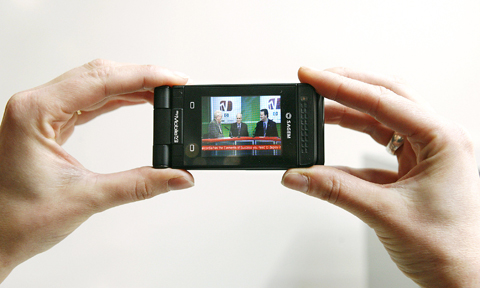For years it was the talk of the wireless industry: Beaming TV to the world’s 4 billion cellphones would be the icon of the digital age. Now, just three letters are hastening the demise of that vision: App.
Short for “application,” the programs people download from online stores to run on their portable phones have enabled consumers to choose for themselves which moving pictures to take in when they are on the go.
As Facebook and Twitter disrupt business models for mainstream media — and on the platform that’s a lifestyle statement for young adults — the one-size-fits-all approach of broadcast mobile TV got stuck before it even properly took off.

PHOTO: REUTERS
“It is a financial disaster,” said John Strand, a consultant who has followed the mobile industry closely for more than 12 years. “It’s a nice product, but the customers won’t pay for it.”
One way to see why not is to watch young Brazilian footballers knocking a soccer ball around in the Helsinki Cup. A youth tournament currently playing in the Finnish capital, it’s hardly a world event in the conventional sense.
But the video clips they are uploading from their phones will run on their parents’ mobiles or PCs back home.
“It’s even easier than with still images, and a much nicer and expressive way to tell them the news from over here,” said David da Silva, spokesman for the team from Brazil.
The service they are using comes from a Web site which offers users the chance to send video from cellphones to their own TV channels on the Web. A small venture, it is one of thousands of offerings from the likes of Apple, Nokia, Research in Motion and many others letting users drive their mobile entertainment.
BBC World and Al Jazeera English have recently launched apps for consumers to watch real-time news on their iPhones, through a London-based company, Livestation.
“This is mobile TV 2.0 — completely reinvented and redesigned and I think it’s going to overtake the old models very very rapidly,” Livestation CEO Matteo Berlucchi said.
Perhaps the best illustration of the fast-shifting outlook is the history of forecasts for the market. Strategy Analytics now expects the mobile TV broadcasting market to total US$280 million next year. Only three years ago the firm forecast the market to reach US$5.4 billion next year.
“We’ve downgraded our forecast a fair bit to reflect the slower-than-anticipated rollout of services and limited momentum from carriers and broadcasters,” Strategy Analytics analyst Nitesh Patel said.
“Application and widget stores and mobile internet access have taken priority over mobile broadcast,” Patel said.
It’s an important distinction, said Andrew Bud, Chairman of the Mobile Entertainment Forum (MEF), a London-based trade association for the mobile media industry. He was talking about mobile TV — which is broadcast — as opposed to mobile video, which you load onto your device.
“Mobile TV is all about real-time, linear transmission ... where the timing of the programming was set by the broadcaster and the consumer would dip in and dip out,” he said.
“Mobile video is much more about video-on-demand. It gives the consumer much more freedom. It’s also a little less stressful on the mobile networks,” he said.
A survey by KPMG and the MEF found that nearly 40 percent of consumers had at one time watched a piece of mobile video on their handset: 52 percent said the experience was satisfying, against 38 percent of a much smaller number of users who said they had tried broadcast mobile TV.
The biggest problem for mobile TV is that it emerged between 2004 and 2006, just when the media industry started to change.
Cellphone makers and mobile operators have invested hundreds of millions of dollars in the infrastructure. Phones and networks are in place in many countries and watching it is very popular in countries such as South Korea where the service is aired for free.
But even there the wide takeup has not created a flourishing business, and in the US it has been a hard slog. Telecoms group Crown Castle International closed down its effort to launch a broadcast mobile TV network in 2007.
Technological strain has been a factor restricting the growth of broadcast TV on mobiles, enabling swift-moving plug-ins to fill the gap.
“A lot of the discussion around mobile TV centered around the vexed question of broadcasting spectrum and special technical standards and it all got very tangled — problems that haven’t been fully resolved, especially in Europe,” Bud said.
Others have included the lack of a clear business model, fights for broadcasting rights, numerous different technologies competing for the leading position and a lack of affordable phone models.
The moving pictures coming slowly onto cellphones are testing demand for different experiences: Samsung and Sony Ericsson have launched movies, the offerings for Apple’s iPhone include TV shows and Nokia has worked with Heroes creator Tim Kring to develop new content for launch in Europe’s summer.
“Consumers are hungry to snack on their favorite content, be that the latest championship soccer goals or Desperate Housewives, said Ben Wood, research director at CCS Insight.
“Old-fashioned broadcasters who are wedded to the old broadcast model have the biggest challenge because those days are over; consumers expect their favorite content when they want it, on whatever platform is most convenient — TV, PC or a mobile phone,” he said.
Samsung has launched a service allowing its customers to buy or rent movies and TV series to download to their mobile phones, with 24-hour rental prices starting from £2.49 (US$3.55) and movies from £4.99.
The breadth of the offering, which includes over 500 blockbusters from top studios Warner Bros, Paramount and Universal, makes it competitive with other mobile media.
Sony Ericsson has unveiled a more limited offering — PlayNow arena with movies — a bundled movie service for selected handsets, allowing consumers to watch up to 60 movies a year on their mobile phone.
“We won’t see major business in just taking TV programs to cellphones,” said Andrea Casalini, Chief Executive of Italian firm Buongiorno, which sells mobile content like games, music, video in 57 countries and says it is the world’s largest mobile entertainment firm.
“There can be big business in new formats — in making shorter programs, shot for cellphone screens, and also in using interactivity,” Casalini said.

STILL COMMITTED: The US opposes any forced change to the ‘status quo’ in the Strait, but also does not seek conflict, US Secretary of State Marco Rubio said US President Donald Trump’s administration released US$5.3 billion in previously frozen foreign aid, including US$870 million in security exemptions for programs in Taiwan, a list of exemptions reviewed by Reuters showed. Trump ordered a 90-day pause on foreign aid shortly after taking office on Jan. 20, halting funding for everything from programs that fight starvation and deadly diseases to providing shelters for millions of displaced people across the globe. US Secretary of State Marco Rubio, who has said that all foreign assistance must align with Trump’s “America First” priorities, issued waivers late last month on military aid to Israel and Egypt, the

‘UNITED FRONT’ FRONTS: Barring contact with Huaqiao and Jinan universities is needed to stop China targeting Taiwanese students, the education minister said Taiwan has blacklisted two Chinese universities from conducting academic exchange programs in the nation after reports that the institutes are arms of Beijing’s United Front Work Department, Minister of Education Cheng Ying-yao (鄭英耀) said in an exclusive interview with the Chinese-language Liberty Times (the Taipei Times’ sister paper) published yesterday. China’s Huaqiao University in Xiamen and Quanzhou, as well as Jinan University in Guangzhou, which have 600 and 1,500 Taiwanese on their rolls respectively, are under direct control of the Chinese government’s political warfare branch, Cheng said, citing reports by national security officials. A comprehensive ban on Taiwanese institutions collaborating or

France’s nuclear-powered aircraft carrier and accompanying warships were in the Philippines yesterday after holding combat drills with Philippine forces in the disputed South China Sea in a show of firepower that would likely antagonize China. The Charles de Gaulle on Friday docked at Subic Bay, a former US naval base northwest of Manila, for a break after more than two months of deployment in the Indo-Pacific region. The French carrier engaged with security allies for contingency readiness and to promote regional security, including with Philippine forces, navy ships and fighter jets. They held anti-submarine warfare drills and aerial combat training on Friday in

COMBAT READINESS: The military is reviewing weaponry, personnel resources, and mobilization and recovery forces to adjust defense strategies, the defense minister said The military has released a photograph of Minister of National Defense Wellington Koo (顧立雄) appearing to sit beside a US general during the annual Han Kuang military exercises on Friday last week in a historic first. In the photo, Koo, who was presiding over the drills with high-level officers, appears to be sitting next to US Marine Corps Major General Jay Bargeron, the director of strategic planning and policy of the US Indo-Pacific Command, although only Bargeron’s name tag is visible in the seat as “J5 Maj General.” It is the first time the military has released a photo of an active